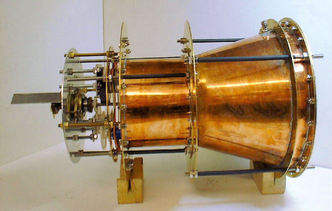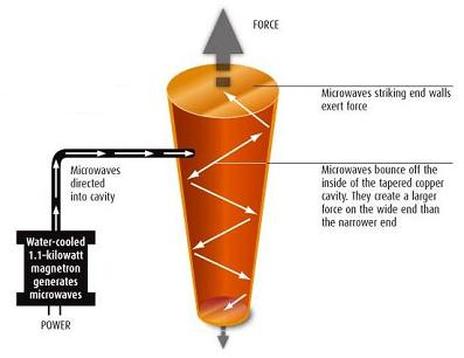 Photo Courtesy of SPR Chinese researchers claim they’ve confirmed the theory behind an "impossible" space drive, and are proceeding to build a demonstration version. If they’re right, this might transform the economics of satellites, open up new possibilities for space exploration - and give the Chinese a decisive military advantage in space. To say that the " Emdrive" (short for "electromagnetic drive") concept is controversial would be an understatement. According to Roger Shawyer, the British scientist who developed the concept, the drive converts electrical energy into thrust via microwaves, without violating any laws of physics. Many researchers believe otherwise. An article about the Emdrive in New Scientist magazine drew a massive volley of criticism. Scientists not only argued that Shawyer’s work was blatantly impossible, and that his reasoning was flawed. They also said the article should never have been published. "It is well known that Roger Shawyer’s ‘electromagnetic relativity drive’ violates the law of conservation of momentum, making it simply the latest in a long line of ‘perpetuum mobiles’ that have been proposed and disproved for centuries," wrote John Costella, an Australian physicist. " His analysis is rubbish and his ‘drive’ impossible."  This is an engine (pictured above) that uses microwaves (and blatant exploitation of Einstein’s laws of relativity) to propel the engine forward without any moving parts or fuel to speak of. A relatively-small electrical charge generates microwaves – using the same device found in the average household microwave — and protects them into a cylinder of just the right size and shape to cause the waves to resonate and multiply in intensity. Stir in some relativity principles, and the thing starts moving toward the fat end of the tube. Make it out of superconductive material that won’t bleed energy and it starts moving fast. Now we’re cooking with… microwaves. Shawyer stands by his theoretical work. His company, Satellite Propulsion Research (SPR), has constructed demonstration engines, which he says produce thrust using a tapering resonant cavity filled with microwaves. He is adamant that this is not a perpetual motion machine, and does not violate the law of conservation of momentum because different reference frames apply to the drive and the waves within it. Shawyer’s big challenge, he says, has been getting people who will actually look into his claims rather than simply dismissing them. Such extravagant claims are usually associated with self-taught, backyard inventors claiming Einstein got it all wrong. But Shawyer is a scientist who has worked with radar and communication systems and was a program manager at European space company EADS Astrium; his work rests entirely on Einstein being right. The thrust is the result of a relativistic effect and would not occur under simple Newtonian physics. Many have dismissed his work out of hand, and British government funding has ceased. He has had some interest from both the United States and China. Now the Chinese connection with the Northwestern Polytechnical University (NPU) in Xi’an seems to have paid off. "NPU started their research program in June 2007, under the supervision of Professor Yang Juan. They have independently developed a mathematical simulation which shows unequivocally that a net force can be produced from a simple resonant tapered cavity," Shawyer tells Danger Room. "The thrust levels predicted by this simulation are similar to those resulting from the SPR design software, and the SPR test results." What’s more, Shawyer says, NPU is "currently manufacturing" a "thruster" based on this theoretical work. The NPU have confirmed that they have reproduced the theoretical work, and are building a demonstration version of the Emdrive. Needless to say, independent confirmation is a big deal — though many will want to see it published in a peer-reviewed journal. Even when it is, I doubt the controversy will subside. Prof. Yang has plenty of experience in this type of area, having previously done work on microwave plasma thrusters, which use a resonant cavity to accelerate a plasma jet for propulsion. While the theory behind the Emdrive is very different, the engineering principles of building the hardware are similar. The Chinese should be capable of determining whether the thruster really works or whether the apparent forces are caused by experimental errors. The thrust produced is small, but significant. Shawyer compares a C-Band Emdrive with the existing NSTAR ion thruster used by NASA. The Emdrive produces 85 mN of thrust compared to 92 for the NSTAR (that’s about one-third of an ounce), but the Emdrive only consumes a quarter of the amount of power and weighs less than 7 kilos, compared to over 30 kilos. The biggest difference is in propellant: NSTAR uses 10 grams per hour; the Emdrive uses none. As long as it has an electricity supply, the Emdrive will keep going. The possibilities are phenomenal: Instead of going out of service when they run out of fuel, satellites would have greatly extended endurance and be able to move around at will. (We wouldn’t have to shoot them down because of the risk from toxic fuel either.) Deep space probes could go further, faster –- and stop when they arrive. Shawyer calculates that a solar-powered Emdrive could take a manned mission to Mars in 41 days. Provided it works, of course. What will China do with the technology? It may be relevant that professor Yang is not unknown in military circles, having published a paper called " Plasma Attack Against Low-Orbit Spy Satellites." Meanwhile, what about the American interest? Shawyer told me that "the flight thruster program is on hold for the present. [O]nce the U.K. government had provided an export license for a U.S. military application, the major U.S. aerospace company we had been dealing with stopped talking to us. " The company may have decided that the Emdrive could not work. If they’re wrong, China has at least a year’s head start in a technology that will dominate space and make previous satellites as obsolete as sailing ships in the age of steam. (Picture: SPR Ltd) Relativity Drive: The End of Wings and Wheels? The device exploits an idea first suggested by Allen Cullen in the 1950s, an electrical engineer then at University College London, that involves forces created by reflecting microwaves between opposite walls of a cavity. The idea is to try to design a cavity in such a manner that forces on one side are greater than the other. The drive comprises a resonant cavity flooded with microwave radiation. The radiation exerts radiation pressure on the walls of the cavity, and normal Newtonian mechanics would of course indicate that, no matter what shape the cavity is, the forces exerted upon it from within must balance to zero. However, Shawyer claims that relativistic effects cause a cavity shaped like a truncated cone to experience a larger force against the large end than the small end, due to the group velocity of the wave changing as the local diameter of the cavity varies. The increased confinement of the tapered end of the cone leads to a higher effective propagation constant (phase velocity). It also leads to local reflections which account for the apparent force imbalance when considering only the end walls. However, since it is the phase of the light rather than the actual photons bouncing off the walls, each force acts quasi independently from another — much like in a ring laser gyroscope where the beams act as if having an external frame of reference (which they have, since the speed of light is constant). The same principle applies to the EmDrive. No microwaves or anything else are allowed to leave the device. Since nothing leaves the drive for propulsive purposes an EmDrive can be classed as a reactionless drive. The principle by which the EmDrive is supposed to operate seems to violate conservation of momentum.[4] However, the emdrive website claims that the device is not reactionless because the force is created by a "reaction between the end plates of the waveguide and the Electromagnetic wave propagated within it."[5] It is known that the physics equations describing microwaves, Maxwell's equations, conserve momentum, and this would seem to cast doubt on Shawyer's derivation of a thrust effect. In his paper, Shawyer thus takes the following view: any thrust extracted from the device is directly withdrawn from the energy stored in the cavity (due to the Q reflections an average wave encounters when inserted into the cavity, the energy levels quickly build up). In other words: the apparent force on the wider diameter of the cone seems to lessen. The extent to which that happens perfectly matches the amount predicted by the law of conservation of momentum. CriticismThe EmDrive was the cover story for the 8 September 2006 issue of New Scientist.[1] After receiving criticism that no peer-reviewed publications on the subject had been made, Mr. Shawyer submitted a theory paper to New Scientist (which is not a peer reviewed scientific journal) [6] Shawyer's paper was almost immediately challenged[4] by Dr. John Costella, a theoretical physicist and electrical engineer who works for the Australian Department of Defence, whose Ph.D. is in relativistic electrodynamics, the field of physics that Mr. Shawyer relies on to support his theory. Prototypes and tests In September 2006 New Scientist reported [1] that Shawyer had constructed a prototype unit weighing 9 kilograms that consumes 700 watts of power and produces 88 millinewtons of force. In May 2007 Eureka magazine reported that a second unit has been built for demonstration purposes, weighing 100 kilograms, consuming 300 watts for microwave production (and an unspecified amount for ancillary purposes such as cooling) and producing 96.1 millinewtons of force during testing in October 2006. Unlike the prototype unit, which can only be run for short periods before burning out its magnetron, the demonstration unit can be run continuously.[7] The limiting factor for performance is claimed to be the Q factor of the cavity, as microwave energy lost to heating the cavity reduces the field strength within, so Shawyer is experimenting with a cavity lined in a superconducting material that may produce Q factors sufficient to build a device capable of generating 30 newtons per watt. These results have neither been reproduced by other scientists or engineers, nor have they been published in a peer-reviewed scientific journal. From Wikipedia @ http://en.wikipedia.org/wiki/EmDrive See the inventor’s website @ http://www.emdrive.com/ Posted by Zach Royer | 6/17/2011 on ApparentlyApparel.com
1 Comment
12/17/2013 06:32:36 pm
Technology Submission - Novel Rotary-Turbo-InFlow Tech - Featured Development
Reply
Your comment will be posted after it is approved.
Leave a Reply. |
News Watch
Mind-opening news articles, editorials, videos & apparel that inspire our readers and help liberate them from the status quo. Stay informed.
Write For UsSpace WatchTop NewsNews Watch Categories
All
|
|
|
HAVE A TIP OR STORY TO TELL? JOIN TODAY & SHARE YOUR STORY!
If you have a breaking news tip or idea, please email: [email protected] Apparently Apparel® is a registered trade name and part of the ZOAT International® brands network. © 2007-2023. All Rights Reserved. Privacy Policy. All art & news content posted on this site is commentary or opinion and is protected under Free Speech. ApparentlyApparel.com is not responsible for content written by contributing artists, authors or news feeds. The information on this site is provided for educational and entertainment purposes only. It is not intended as a substitute for professional advice of any kind. ApparentlyApparel.com assumes no responsibility for the use or misuse of this material.
|
|







